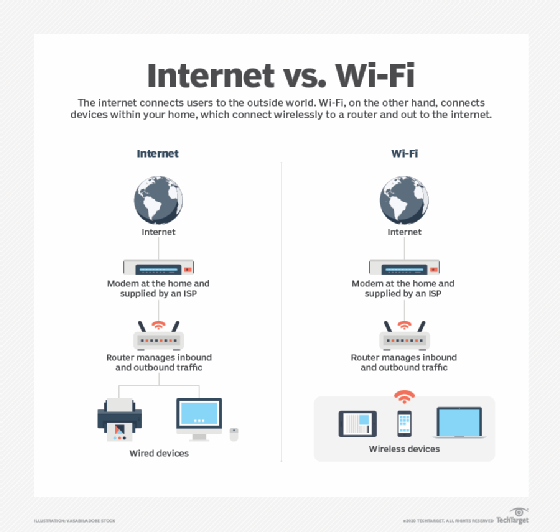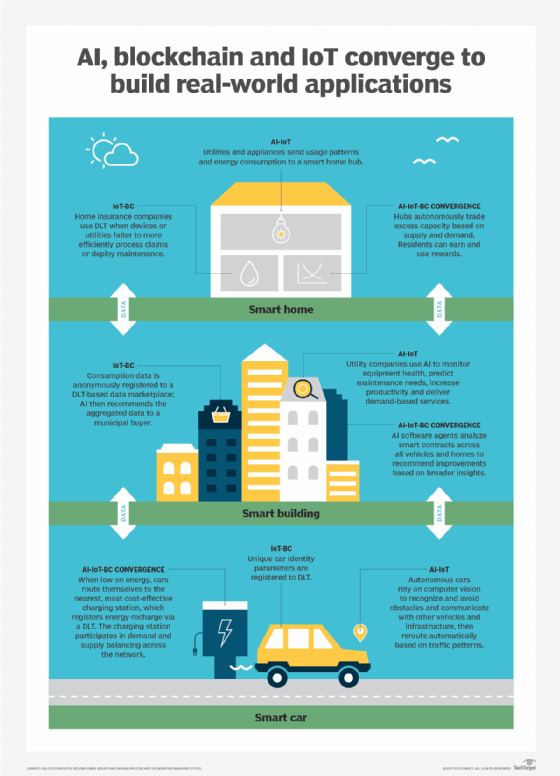technological convergence
What is technological convergence?
Technological convergence is a term that describes bringing previously unrelated technologies together, often in a single device. Smartphones might be the best possible example of such a convergence. Prior to the widespread adoption of smartphones, consumers generally relied on a collection of single-purpose devices. These devices included telephones, wristwatches, digital cameras and global positioning system (GPS) navigators. Today, even low-end smartphones combine the functionality of all these separate devices, easily replacing them in a single device.
Technological convergence consists of the integration, merging or the blending together of different technologies to create a new product or offering. It's a broad concept that covers a wide range of technologies. Converged technologies can replace single-function technologies but might also provide an alternative product offering. For example, smartphones have for the most part replaced GPSes, but graphing calculators are still a popular single-function technology.
Technological convergence often provides convenience to consumers, saving space, time or energy. Depending on the converged technologies, the process also has the potential to change the way people live. For business owners, understanding technological convergence can increase their organization's competitiveness.
Why is technological convergence important?
From a consumer perspective, technological convergence is often synonymous with innovation. Technologies rarely converge in their current form. Improvements are often introduced as part of the convergence. Consider the popularity of video cameras a generation ago. Today, consumer-grade video cameras are almost nonexistent. Most people record videos on their mobile devices. Although they can eliminate the need to carry a separate device -- a video camera, in this case -- these pocket-size cameras also deliver superior video quality as compared to what was once available. Most video cameras from the early 2000s had a maximum resolution of 480i (720 x 480) and often experienced poor battery life. In contrast, a modern mobile device can record in 4K (4096 x 2160) resolution. In addition, mobile device batteries often last for a day or more, depending on how the device is being used.
Another reason why technological convergence is important from a consumer perspective is because it results in easier access to technology at a lower cost. This trend is sometimes referred to as the consumerization of IT.
Wi-Fi is a perfect example of this. Although Wi-Fi was available in the late 1990s, a Wi-Fi router cost thousands of dollars and, typically, could only be set up by an IT pro. Today, Wi-Fi is ubiquitous. Nearly every consumer electronic device is Wi-Fi enabled. In addition, prices are much lower than they once were, and Wi-Fi routers have been greatly simplified to the point that a non-tech-savvy person can set them up. Such benefits stem directly from technological convergence.
Technological convergence also improves personal and business-related efficiency efforts. By combining two or more single-purpose technologies into one tool, service or software, for example, individuals can save time and effort while streamlining their activities.
For businesses, technological convergence means they're more easily able to connect with their customers and learn more about their buying habits. In some cases, technological convergence even enables a business to influence a customer's purchases. Internally, technological convergence can improve business processes, making them more efficient. For example, unified communications services integrate numerous enterprise communication technologies, making inter-company communications more efficient.

Types of convergence
The idea of convergence is broad in scope, as it can apply to many different fields. The types of convergence that surround technology can include the following:
- Media. Media convergence joins together different media, media platforms, access points and the internet. For example, a consumer can watch a YouTube video on their desktop, phone, TV or tablet. Likewise, they can read a novel on physical media like a book, on a digital platform like a website or on a digital device such as a Kindle or smartphone.
- Network. Network convergence combines telephone, voice, video and data communication. An example of this is when a provider converges mobile, Wi-Fi, Ethernet and voice over Internet Protocol (VoIP) to create a communication service.
- IT. IT is a field that has been integrated with other fields, such as operational technology (OT) and cloud-based services. IT/OT convergence brings physical (OT) equipment and devices into the digital (IT) realm. IT hardware and software have also contributed to the anything-as-a- service model.
The history and origin of technological convergence
Technological convergence is the result of disruptive innovation that combines the previously siloed fields of telecommunications, IT and media. This movement dates to an era before the prevalence of mobile wireless networks. At the time, telecommunication providers operated fixed traditional phone networks.
Technology convergence started accelerating and became more apparent in the 1990s, due to advancements in computing and affordability. For example, mobile phones appeared in the 1990s as a convenient way to make phone calls on the go. More recently, smartphones that support various functions through a single interface emerged -- these functions could include gaming, listening to music, checking email or texting. In addition to multimedia, smart devices include GPS tracking, which supports location-based services for providing information, entertainment or advertising.
Mainstream internet adoption fueled further convergence by telecom service providers. This led to the development of network convergence and media convergence, which enables data, video and voice services to be delivered on a single network. Providers once limited to telephone services can offer bundled packages of cable TV, voice and internet access for a monthly rate.
Numerous companies have achieved technological convergence. For example, Apple's first iPhone combined voice call and text messaging features in a device that also converged email, web browsing, GPS and MP3 player technologies. Likewise, IBM services featured examples of network convergence that combined voice, video and data networks. Netflix, which used to provide a physical mail-order movie rental service, converged media like movies with online streaming services -- popularizing the movie and TV show streaming model.
Current technologies that are beginning to see technological convergence include the internet of things (IoT) and artificial intelligence (AI). IoT, as a concept, converges multiple devices or sensors to collect data at different endpoints, while sending that data to a centralized device for analysis. Different AI tools have also been developed as a result of the convergence of technologies, including machine learning (ML), deep learning and natural language processing (NLP).
Examples of technological convergence
A good way to evaluate the importance of technological convergence is to consider innovations from previous generations. Items such as CD players, cassette decks, console TVs or corded telephones served only one function, whereas a single modern handheld computing device can meld several of those functions with hardly any user intervention required.
Aside from telecommunications and media, technological convergence is starting to pervade other old-line industries. Initially, most newspapers and other print-based products and services had little to no internet presence. Over time, news outlets recognized the value of integrating new media to deliver real-time content and boost the reach of their advertisers.
People who aren't computer-literate are more likely to embrace the internet and video on demand if they can access these technologies through their TV. TV is familiar and nonthreatening. Displays are large and TVs are easy to operate. Using them to access the web requires almost no training.
Electric vehicles also underscore the blurred lines between disparate technologies. Because they run on alternative fuels, these vehicles must tap into an interconnected electricity grid while also interacting with internet technologies to analyze and transmit the data they collect.
Technological convergence is also seen in AI, as different technologies -- such as ML, deep learning, computer vision and NLP -- are all used to create new AI-enabled products. Chatbots, for example, are designed with ML and natural language algorithms. Although online storefronts and other websites commonly integrate chatbots into their websites, there are other types of chatbots used too. Virtual assistants, such as Amazon Alexa, Apple Siri, and Google Assistant are AI chatbots.
Likewise, new technologically converged products like the Rabbit R1 AI personal assistant developed by Rabbit, Inc., are emerging AI products.
Another example of technological convergence is the way that AI, blockchain and IoT technologies are converging to enable tamperproof distributed ledger technology (DLT). DLT is widely used in banking and cryptocurrency applications but also has other uses. Some data backup providers, for example, have adopted blockchain technology as a tool to make sure backups can't be tampered with or encrypted by ransomware.

Technological convergence also enables the film industry to lower costs and add more interesting effects with digital production. However, digitized content is vulnerable to piracy through content ripping, and production houses might lose revenue as more viewers opt for video streaming in place of going to a movie theater.
Data centers are increasingly considering converged infrastructure (CI) or hyperconverged infrastructure (HCI). In CI, companies can buy compute, networking, server and storage components by the rack. HCI packages all the components on a single appliance.
What are the advantages of technological convergence?
There are several advantages to technological convergence, including the following:
- Innovation. Technological convergence can spur innovation while also reducing the need for single-use devices. Part of this innovation has to do with component miniaturization, as manufacturers must make electronic components smaller if they're to build evermore capable devices.
- All-in-one piece of technology. Technological convergence also helps consumers use devices in the way that best meets their needs. At one time, making a telephone call was the only option for speaking with someone over long distances. Today, a smartphone supports telephone calls, VoIP calls through messaging apps and video calls. Additionally, such devices enable communications through text messages, email and other text-based services.
- Reduced costs. Technological convergence can also help reduce costs. Purchasing internet, television and telephone service as a bundle is likely to be cheaper than subscribing to these services separately. Similarly, buying a smartphone costs less than purchasing a collection of single-purpose devices.
- Simplified management. It's easier to manage one device than it is to manage many. Likewise, it is easier to manage a single converged network than it is to manage multiple separate networks, for example.
What are the disadvantages of converging technologies?
Despite its advantages, technological convergence comes with notable drawbacks, including the following:
- Complexity. Due to the complexity of delivering internet, video and voice services, network providers must make expensive investments in computing, networks, security and continuous software development. These costs are generally absorbed by consumers in the form of higher rates or service fees.
- Points of failure. Converging services such as voice, video and internet can increase the severity of an outage. When these services were all separate, a telephone outage would only affect voice service. The same was true for video and internet services. But when these services are bundled together and delivered through a single connection, a service disruption can potentially lead to customers being without all these services for the duration of the outage.
Also, although they compete in a regulated industry, telecom service providers own the existing network infrastructure and might be reluctant to share it with rivals. This creates a barrier to entry for new companies to bring innovations to the market. This situation has led to a debate over net neutrality rules in the U.S. that were enacted in 2015 to treat broadband services as a utility and prevent providers from giving preference to services they own over competing services. The Federal Communications Commission (FCC) repealed the rules in 2018 after a series of legal challenges. Then, in April 2024, the FCC voted to restore nationwide net neutrality rules. - Compatibility and form factor. From a user perspective, form factor plays a role in the efficiency of the converged technologies. Although you can open a web browser on a smartphone, a mobile device might not be equipped to provide the same functionality as a desktop or PC due to its relatively small screen size. A physical device's form factor inevitably makes that device better suited to some use cases over others.
- Data privacy. Given the pervasive nature of data collection enabled by converged technologies, it can be difficult for users to fully understand when data is being mined by technology companies and how it's being used to build a personal profile. Wearable devices, lapses in cybersecurity and the proliferation of mobile devices have increased the attack surface hackers can use to steal personally identifiable information. These concerns have sparked debate on the need for additional regulations in the U.S., similar to the General Data Protection Regulation laws that govern data privacy in EU member countries.
- Security. Other security issues can also stem from digital convergence. Consumer-oriented IoT devices have long had a reputation for weak security. If an attacker were to successfully hack such a device, the attacker could potentially use the compromised device as a platform for attacking other devices that are connected to the same network. This can include data-rich devices such as PCs, tablets and smartphones.
Technological convergence has the potential to change the way businesses and consumers operate daily. Learn more about technological convergence's impact on data centers.






